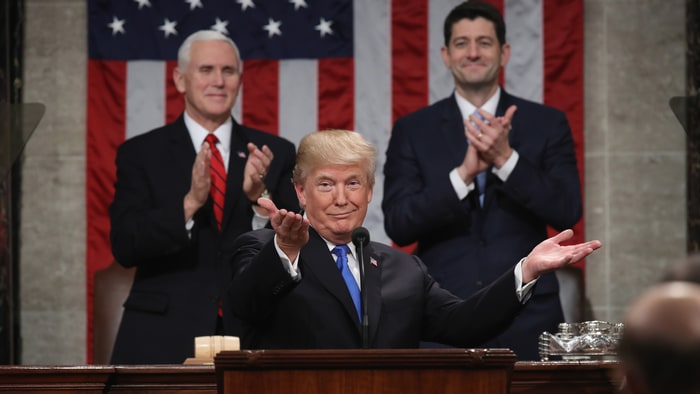State of the Union 2018: Same Rhetoric, Different Tone
Jan 31, 2018
President Donald Trump gave his first State of the Union Address on Tues., Jan. 30 in front of a joint session of Congress. This address came at a time of a huge political divide, with growing debate over the DACA program and immigration reform. The address mostly focused on what Trump has accomplished so far, and what he hopes to achieve in the next year.
The President put on his most professional tone, keeping calm and collected throughout his delivery. Naturally, the beginning of his speech consisted of self-congratulatory talk, with Trump listing his supposed accomplishments within the past year, with the following theme, “Clap, stand. Clap, stand. Braggadocio. Clap, stand. Clap, stand.” This never ending torrent of clapping and standing continued on throughout the entire duration of the one and a half hour speech, which was the second longest State of the Union ever delivered.
Overall, the speech didn’t stray, and Trump stuck to the script, unlike his recent speech at the DAVOS economic conference in Switzerland. When he typically strays from the script, Trump tends to say more controversial comments, which he was thankfully able to avoid this time around.
Junior Umar Ahmed believes that the overall speech was better than most Trump has given in the past, but there was still room for improvement.
“I think President Trump did better in comparison to speeches he’s given in his past. However, substantively, I feel it wasn’t the best. Trump did what he did last time, having families that lost someone, so he could garner support for his immigration initiatives,” Ahmed said. “Aside from that, I felt that he spent a lot of time trying to legitimize the campaign promises he made, like trying to gain momentum for the wall and also enforce his stance on the U.S Embassy in Israel. I believe that the intention of a unity oriented speech was good, but I feel that his speech was nothing more than muddling and divisive.”
Of course, there were the heartfelt moments, such as the story of the police officer who adopted a heroin addict’s child, which was unquestionably one of the highlights of the speech. By focusing on the good side of America, the feel-good stories of success and triumph, Trump was able to portray his overall message of unity.
Even when talking about one of these heartfelt stories, Trump used them as ways to take indirect shots at other people or groups. For example, when telling the story of Preston Sharp, who has raised awareness about remembering veterans, he took a blatant stab at the NFL; he stated that we must all stand for and respect the flag, an allusion to his ongoing feud with Colin Kaepernick and other players who protest the national anthem by kneeling.
Junior Caelin Muniz noticed parts of his address similar to the aforementioned story.
“I get that he’s trying to make his case for more strict regulations and rules, but I feel like it’s a part of his bigger picture, anti-immigrant rhetoric,” Muniz said. “He’s trying to turn more people against people entering our country from Mexico by appealing to people’s sense of sympathy. It was just part of his bigger scheme to get people against immigration.”
Immigration was one of Trump’s most talked about issues in his speech. He outlined his four pillars for immigration reform, the first being offering 1.8 million undocumented immigrants who were brought over by their parents a pathway to citizenship over a period of 12 years. The second pillar however, requires funding and building a wall on the southern border with Mexico and ends loopholes in the immigration code that allow “criminals and terrorists” in the county. His third is the ending of the lottery system of immigration, which he claims hands out green cards to people without any skills or merit. Finally, his fourth pillar is to “protect the nuclear family” and end chain-migration by limiting sponsorships to only close family, such as minor children and spouses.
It’s unlikely Democrats will agree to this supposedly bi-partisan immigration reform, considering it would allow funding for the border wall and end the lottery system of immigration.
Trump ended his speech on a high note, calling for stronger unity by stating that America was built upon people with dreams and a drive for bettering the country, and anyone can achieve that dream by having confidence in their values.
Shortly after Trump’s address, a rising star within the Democratic Party, Joe Kennedy III, great-nephew of president John F. Kennedy and a U.S representative for Massachusetts’s 4th district, gave an impassioned oration calling out Trump for his hateful comments towards immigrants and divisive speech.
Social studies teacher Melanie Johnson commented on the two speeches of the night, detailing its possible effects on the Democratic name and chances for 2018.
“I think that it’s pretty unlikely that the response to the State of the Union is going to be something that comes into the 2018 midterms [where] people are like, ‘I’m voting for a Democrat because of something that was said in a response to the State of the Union.’ I think it’s more about whether or not some of the themes and ideas in that speech are things that Democratic members of Congress fight for, and people are going to want to vote for them more so than the speech itself,” Johnson said.
All in all, the President’s speech was a modest attempt at bringing unity to the country, but because of his still strong rhetoric on immigration, it’s unlikely he did much to help win over Democrats to support his reform ideals. However, the speech was strongly aimed towards energizing his original base of supporters, which he was mostly likely successful at.





Mans rights • Jan 31, 2018 at 9:22 PM
Great speech. Trump talked about whats best for America, while Droolin’ Joe Kennedy centered his speech around illegal immigrants. Donald Trump cares about the average American, while the democrats only care about “black lives matter” and DACA. Remember that when you vote in the midterms